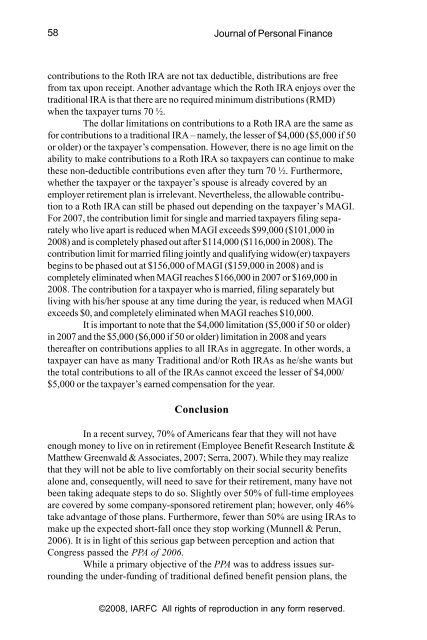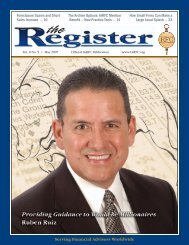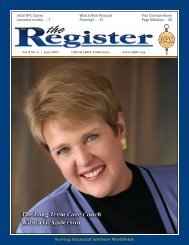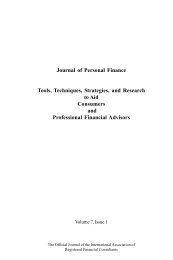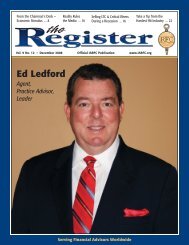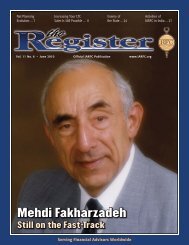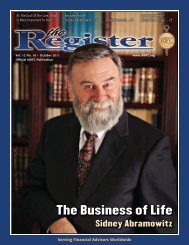3433-vol. 6 issue 2-3.pmd - iarfc
3433-vol. 6 issue 2-3.pmd - iarfc
3433-vol. 6 issue 2-3.pmd - iarfc
You also want an ePaper? Increase the reach of your titles
YUMPU automatically turns print PDFs into web optimized ePapers that Google loves.
58<br />
Journal of Personal Finance<br />
contributions to the Roth IRA are not tax deductible, distributions are free<br />
from tax upon receipt. Another advantage which the Roth IRA enjoys over the<br />
traditional IRA is that there are no required minimum distributions (RMD)<br />
when the taxpayer turns 70 ½.<br />
The dollar limitations on contributions to a Roth IRA are the same as<br />
for contributions to a traditional IRA – namely, the lesser of $4,000 ($5,000 if 50<br />
or older) or the taxpayer’s compensation. However, there is no age limit on the<br />
ability to make contributions to a Roth IRA so taxpayers can continue to make<br />
these non-deductible contributions even after they turn 70 ½. Furthermore,<br />
whether the taxpayer or the taxpayer’s spouse is already covered by an<br />
employer retirement plan is irrelevant. Nevertheless, the allowable contribution<br />
to a Roth IRA can still be phased out depending on the taxpayer’s MAGI.<br />
For 2007, the contribution limit for single and married taxpayers filing separately<br />
who live apart is reduced when MAGI exceeds $99,000 ($101,000 in<br />
2008) and is completely phased out after $114,000 ($116,000 in 2008). The<br />
contribution limit for married filing jointly and qualifying widow(er) taxpayers<br />
begins to be phased out at $156,000 of MAGI ($159,000 in 2008) and is<br />
completely eliminated when MAGI reaches $166,000 in 2007 or $169,000 in<br />
2008. The contribution for a taxpayer who is married, filing separately but<br />
living with his/her spouse at any time during the year, is reduced when MAGI<br />
exceeds $0, and completely eliminated when MAGI reaches $10,000.<br />
It is important to note that the $4,000 limitation ($5,000 if 50 or older)<br />
in 2007 and the $5,000 ($6,000 if 50 or older) limitation in 2008 and years<br />
thereafter on contributions applies to all IRAs in aggregate. In other words, a<br />
taxpayer can have as many Traditional and/or Roth IRAs as he/she wants but<br />
the total contributions to all of the IRAs cannot exceed the lesser of $4,000/<br />
$5,000 or the taxpayer’s earned compensation for the year.<br />
Conclusion<br />
In a recent survey, 70% of Americans fear that they will not have<br />
enough money to live on in retirement (Employee Benefit Research Institute &<br />
Matthew Greenwald & Associates, 2007; Serra, 2007). While they may realize<br />
that they will not be able to live comfortably on their social security benefits<br />
alone and, consequently, will need to save for their retirement, many have not<br />
been taking adequate steps to do so. Slightly over 50% of full-time employees<br />
are covered by some company-sponsored retirement plan; however, only 46%<br />
take advantage of those plans. Furthermore, fewer than 50% are using IRAs to<br />
make up the expected short-fall once they stop working (Munnell & Perun,<br />
2006). It is in light of this serious gap between perception and action that<br />
Congress passed the PPA of 2006.<br />
While a primary objective of the PPA was to address <strong>issue</strong>s surrounding<br />
the under-funding of traditional defined benefit pension plans, the<br />
©2008, IARFC All rights of reproduction in any form reserved.


